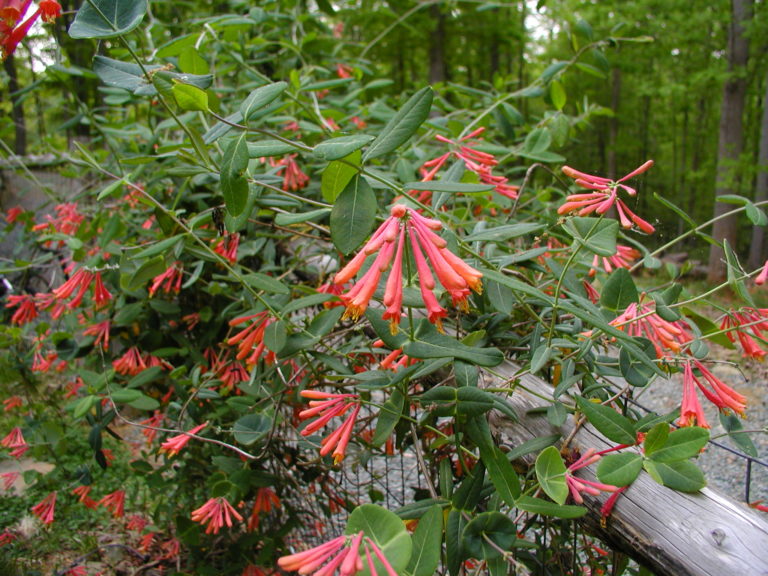It is a joy to write about Scarlet Honeysuckle today because as I write, the intensely scarlet flowers are brightening up the green world along my driveway. Because it is a climber, the deep crimson color meets the eye at different elevations (although it does not seem to flower on the ground). Here in the piedmont it is deciduous, though evergreen in the Deep South. This plant is adapted from Maine to Florida and over to Texas, but does not appear in the mountain counties of North Carolina or Virginia. It was adopted as Wildflower of the Year in 2014 by the Virginia Native Plant Society (vnps). Coral Honeysuckle is famous for attracting hummers, and in fact (according to the vnps.org) the combination of its bright red tubular flowers with abundant nectar and little floral odor typifies the usual pattern for hummingbird-pollinated species. Unlike its horribly invasive Asian cousin, Lonicera japonica, Coral Honeysuckle is a well behaved garden plant. It climbs by twining, and it will reward the gardener who plants it (in organically rich, moist but well drained soil, beneath a trellis or fence in full sun or partial sun), with a heart-lifting vision of deep scarlet flowers, usually with golden interiors, as well as of the visiting hummers.
NURSERY HOURS
Wednesday – Saturday: 10-4, Sunday: 12-4
Lonicera sempervirens

Key Info
Scientific Name: Lonicera sempervirens L.
Common Names: Coral Honeysuckle, Trumpet Honeysuckle, Woodbine
Family Names: Caprifoliaceae (Honeysuckle Family)
Plant Type: Vine
Leaf Retention: Deciduous
Flower Color: Red
Additional Info
Habit: High-climbing, twining semi-woody vine, 15-20 ft. long, with scarlet flowers followed by bright-red berries; older stems have papery brown exfoliating bark. Tap root.
Height: 15' - 20'
Spread: Indeterminate
Soil Conditions: Moist well drained; acidic to basic, prefers organic; sandy, sandy loam, medium loam, clay loam, clay.
Leaves: The opposite leaves, up to 3 inches long x 2 inches across, are oval, glossy, with entire margins. They are usually smooth and hairless on both surfaces, green above, with a white bloom below. Leaves of upper nodes can be sessile. Directly below the flowers, and where branching occurs, the opposite leaves merge around the stem (perfoliate). The leaves are evergreen in winter in the Deep South.
Flowers (or reproductive structures: The inflorescence consists of several closely spaced whorls of 3-6 narrow, sessile, non-fragrant, trumpet-shaped flowers borne on the stem tips, above the disc-shaped leaves. They are scarlet to orange-red on the outside and often yellow inside (but sometimes all red, orange, or yellow). Corollas are tubular,1-2 inches long, with five lobes and five yellow anthers, with the stigma projecting slightly beyond the anthers.
Fruit: Each fertile flower develops into a single fruit about 3/8 inch across. Each fruit becomes bright red when it is ripe and contains a single seed. They are inedible to people but consumed by birds, and are ornamentally significant.
Natural Distribution: Inhabits a wide variety of forests and successional habitats.
USDA Hardiness Zone: 4-9
USDA Wetland Indicator Status in NC: FACU
Pollination: Hummingbirds, bees butterflies, other insects.
Wildlife Connections: The plant leaves support larvae of Spring Azure, the Hummingbird Clearwing and Snowberry Clearwing Moths, among other insect. Flowers provide nectar for Ruby-Throated Hummingbirds; attract bees and butterflies. Fruits are consumed by Quail, Purple Finches, Goldfinches, Hermit Thrushes, American Robins.
Propagation: From cuttings in spring/summer, and from seeds.
